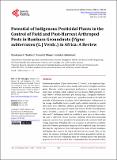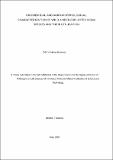Vigna Legumes: Exploring Some Biochemical Constituents of the Wild Species for Potential Neo-Domestication Candidates
| dc.contributor.author | Harouna, Difo | |
| dc.contributor.author | Ndakidemi, Patrick | |
| dc.contributor.author | Venkataramana, Pavithravani | |
| dc.contributor.author | Matemu, Athanasia | |
| dc.date.accessioned | 2023-09-27T09:09:50Z | |
| dc.date.available | 2023-09-27T09:09:50Z | |
| dc.date.issued | 2022-09-14 | |
| dc.identifier.uri | https://doi.org/10.21203/rs.3.rs-2024097/v1 | |
| dc.identifier.uri | https://dspace.nm-aist.ac.tz/handle/20.500.12479/2075 | |
| dc.description | This research article was published in the Research Square, 2022 | en_US |
| dc.description.abstract | Due to the foresight of food system collapse, the search for alternative food and feed sources for human and animal nutrition becomes a daunting task. In addition, achieving Zero Hunger target by the year 2030 as set by the FAO is challenging. Re-exploring the less explored foods, coupled to refining less refined traits, cultivating the uncultivated, and popularizing the unpopular food crops are steps to achieve the domestication of wild plants for food and nutrition security. In that line of thought, this study explored the proximate composition of 87 accessions of four wild unexplored Vigna species in order to reveal information leading to their future domestication and utilization. Standard procedures and methods approved by AOAC were used in carrying out the proximate composition of the wild Vigna legumes. The study revealed that the wild Vigna species possess a large variation range of nutrient characteristics which could be exploited in the improvement of domesticated species or guide their domestication. It was also found that some individual wild accessions have higher nutrient, content as compared with domesticated ones which could be advantageous for bio-fortification or domestication. Indications relating to the candidate accessions favorable for domestication, based on the nutrient characteristics were revealed. | en_US |
| dc.language.iso | en | en_US |
| dc.publisher | Research Square | en_US |
| dc.subject | Vigna species | en_US |
| dc.subject | Vigna racemosa | en_US |
| dc.subject | Vigna ambacensis | en_US |
| dc.subject | Vigna reticulata | en_US |
| dc.subject | Vigna vexillata | en_US |
| dc.subject | Wild legumes | en_US |
| dc.subject | Proximate composition | en_US |
| dc.title | Vigna Legumes: Exploring Some Biochemical Constituents of the Wild Species for Potential Neo-Domestication Candidates | en_US |
| dc.type | Article | en_US |




